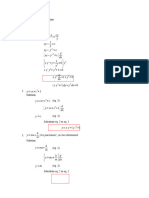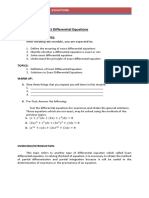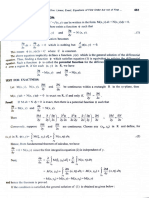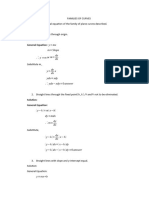Differential Equations:: Cagayan State University-Carig Campus
Uploaded by
john dave rivasDifferential Equations:: Cagayan State University-Carig Campus
Uploaded by
john dave rivasCagayan State University–Carig Campus
COLLEGE OF ENGINEERING
DEPARTMENT OF CIVIL ENGINEERING
LECTURE MODULE 5
DIFFERENTIAL EQUATIONS: CHAPTER 2
TOPIC 5
HOMOGENEOUS DIFFERENTIAL EQUATIONS
It was discussed in the first module how to classify a differential equation according to its type, degree, order
and linearity. In Chapter 2, we are going to study all the different solutions in solving a differential equation in the
first order and first degree. There are several solutions in solving these types of differential equations but each one
must follow a particular condition in order to use the solution.
A differential equation may also be solved in more than one solution and it is up to you, students, what to use
for as long as the equation satisfies the condition for the particular solution. Each solution will be presented then
according to the level of difficulty.
At the end of this lesson, the student will be able to:
1. examine the applicable solution to solve a first-order first-degree differential equation;
2. perform the solution for homogeneous differential equations.
1.1 Homogeneous Differential Equations
A function 𝑓(𝑥, 𝑦) is said to be homogeneous of degree 𝒌, if and only if for every real number 𝜆,
𝑓(𝜆𝑥, 𝜆𝑦) = 𝜆𝑘 𝑓(𝑥, 𝑦)
The definition holds true for all the functions of more than two variables.
Example 1:
Determine whether 𝑓(𝑥, 𝑦) = 𝑥𝑦 + 2𝑦 2 + 3𝑥 2 is homogeneous or not.
Solution:
𝑓(𝑥, 𝑦) = 𝑥𝑦 + 2𝑦 2 + 3𝑥 2
𝑓(𝜆𝑥, 𝜆𝑦) = (𝜆𝑥)(𝜆𝑦) + 2(𝜆𝑦)2 + 3(𝜆𝑥)2
𝑓(𝜆𝑥, 𝜆𝑦) = (𝜆2 𝑥𝑦) + 2(𝜆2 𝑦 2 ) + 3(𝜆2 𝑥 2 )
𝑓(𝜆𝑥, 𝜆𝑦) = 𝜆2 (𝑥𝑦 + 2𝑦 2 + 3𝑥 2 )
𝑓(𝜆𝑥, 𝜆𝑦) = 𝜆2 𝑓(𝑥, 𝑦)
Since 𝒇(𝝀𝒙, 𝝀𝒚) = 𝝀𝟐 𝒇(𝒙, 𝒚), the function is homogeneous of degree 2.
Theorem 1:
If 𝑀(𝑥, 𝑦) and 𝑁(𝑥, 𝑦) are both homogeneous of degree 𝑘, the quotient
𝑀(𝑥, 𝑦)
𝑁(𝑥, 𝑦)
is homogeneous of degree zero.
ENGR. ARISTON C. TALOSIG 1 | Page
Cagayan State University–Carig Campus
COLLEGE OF ENGINEERING
DEPARTMENT OF CIVIL ENGINEERING
LECTURE MODULE 5
DIFFERENTIAL EQUATIONS: CHAPTER 2
Theorem 2:
A differential equation 𝑀(𝑥, 𝑦)𝑑𝑥 + 𝑁(𝑥, 𝑦)𝑑𝑦 = 0 is said to be homogeneous if the functions 𝑀(𝑥, 𝑦) and 𝑁(𝑥, 𝑦)
are both homogeneous of degree 𝑘.
The equation 𝑀(𝑥, 𝑦)𝑑𝑥 + 𝑁(𝑥, 𝑦)𝑑𝑦 = 0 can be written in the form 𝐶(𝑥)𝑑𝑥 + 𝐷(𝑦)𝑑𝑦 = 0 by using the substitution
𝒚 = 𝒗𝒙 or 𝒙 = 𝒖𝒚. It will be the student’s discretion to use which transformation expression he wishes to use,
according to his own ease.
Example 2:
Find the general solution of the equation 𝑥𝑦𝑑𝑥 − (𝑥 2 + 3𝑦 2 )𝑑𝑦 = 0.
Solution:
Check whether the given equation is homogeneous.
𝑀(𝑥, 𝑦) = 𝑥𝑦
𝑀(𝜆𝑥, 𝜆𝑦) = (𝜆𝑥)(𝜆𝑦)
𝑀(𝜆𝑥, 𝜆𝑦) = 𝜆2 (𝑥𝑦)
𝑀(𝜆𝑥, 𝜆𝑦) = 𝝀𝟐 𝑀(𝑥, 𝑦)
𝑁(𝑥, 𝑦) = −(𝑥 2 + 3𝑦 2 )
𝑁(𝜆𝑥, 𝜆𝑦) = −[(𝜆𝑥)2 + 3(𝜆𝑦)2 ]
𝑁(𝜆𝑥, 𝜆𝑦) = −[𝜆2 𝑥 2 + 3𝜆2 𝑦 2 ]
𝑁(𝜆𝑥, 𝜆𝑦) = −𝜆2 (𝑥 2 + 3𝑦 2 )
𝑁(𝜆𝑥, 𝜆𝑦) = 𝝀𝟐 𝑁(𝑥, 𝑦)
Since both 𝑀(𝑥, 𝑦)and 𝑁(𝑥, 𝑦) are homogeneous of degree 2, then the differential equation is homogeneous.
Choose which expression you wish to use: 𝑦 = 𝑣𝑥 or 𝑥 = 𝑢𝑦. In this example, the lecturer opted to use 𝑥 = 𝑢𝑦.
𝑥 = 𝑢𝑦
𝑑𝑥 = 𝑢 𝑑𝑦 + 𝑦 𝑑𝑢
Substitute 𝑥 and 𝑑𝑥 to the given equation.
𝑥𝑦𝑑𝑥 − (𝑥 2 + 3𝑦 2 )𝑑𝑦 = 0
(𝑢𝑦)𝑦(𝑢 𝑑𝑦 + 𝑦 𝑑𝑢) − [(𝑢𝑦)2 + 3𝑦 2 ]𝑑𝑦 = 0
𝑢2 𝑦 2 𝑑𝑦 + 𝑢𝑦 3 𝑑𝑢 − (𝑢𝑦)2 𝑑𝑦 − 3𝑦 2 𝑑𝑦 = 0
𝑢2 𝑦 2 𝑑𝑦 + 𝑢𝑦 3 𝑑𝑢 − 𝑢2 𝑦 2 𝑑𝑦 − 3𝑦 2 𝑑𝑦 = 0
𝑢𝑦 3 𝑑𝑢 − 3𝑦 2 𝑑𝑦 = 0
Solve using separation of variables.
𝑢𝑦 3 𝑑𝑢 − 3𝑦 2 𝑑𝑦 = 0
𝑦3
𝑢𝑦 𝑑𝑢 3𝑦 2 𝑑𝑦
3
− =0
𝑦3 𝑦3
𝑑𝑦
𝑢𝑑𝑢 − 3 =0
𝑦
𝑑𝑦
∫ 𝑢𝑑𝑢 − 3 ∫ = ∫0
𝑦
𝑢2
− 3 ln 𝑦 = 𝐶
2
𝑢2 − 6 ln 𝑦 = 2𝐶
𝑢2 − 6 ln 𝑦 = 𝐶
ENGR. ARISTON C. TALOSIG 2 | Page
Cagayan State University–Carig Campus
COLLEGE OF ENGINEERING
DEPARTMENT OF CIVIL ENGINEERING
LECTURE MODULE 5
DIFFERENTIAL EQUATIONS: CHAPTER 2
𝑥
Substitute original variables. Since 𝑥 = 𝑢𝑦, then 𝑢 = ,
𝑦
𝑥 2
( ) − 6 ln 𝑦 = 𝐶
𝑦
𝑥2
− 6 ln 𝑦 = 𝐶
𝑦2
𝒙𝟐 − 𝟔𝒚𝟐 𝐥𝐧 𝒚 = 𝑪𝒚𝟐
Note: The student is encouraged to try using 𝑦 = 𝑣𝑥 and do same process as above. The answer or solution for the
differential equation must be the same.
Example 3:
Find the general solution of the equation (𝑥 − 2𝑦)𝑑𝑥 + (2𝑥 + 𝑦)𝑑𝑦 = 0.
Solution:
Check whether the given equation is homogeneous.
𝑀(𝑥, 𝑦) = 𝑥 − 2𝑦
𝑀(𝜆𝑥, 𝜆𝑦) = (𝜆𝑥) − 2(𝜆𝑦)
𝑀(𝜆𝑥, 𝜆𝑦) = 𝜆(𝑥 − 2𝑦)
𝑀(𝜆𝑥, 𝜆𝑦) = 𝝀𝑀(𝑥, 𝑦)
𝑁(𝑥, 𝑦) = 2𝑥 + 𝑦
𝑁(𝜆𝑥, 𝜆𝑦) = 2(𝜆𝑥) + (𝜆𝑦)
𝑁(𝜆𝑥, 𝜆𝑦) = 𝜆(2𝑥 + 𝑦)
𝑁(𝜆𝑥, 𝜆𝑦) = 𝝀𝑁(𝑥, 𝑦)
Since both 𝑀(𝑥, 𝑦)and 𝑁(𝑥, 𝑦) are homogeneous of degree 1, then the differential equation is homogeneous.
Choose which expression you wish to use: 𝑦 = 𝑣𝑥 or 𝑥 = 𝑢𝑦. In this example, the lecturer opted to use 𝑦 = 𝑣𝑥.
𝑦 = 𝑣𝑥
𝑑𝑦 = 𝑣 𝑑𝑥 + 𝑥 𝑑𝑣
Substitute 𝑦 and 𝑑𝑦 to the given equation.
(𝑥 − 2𝑦)𝑑𝑥 + (2𝑥 + 𝑦)𝑑𝑦 = 0
[𝑥 − 2(𝑣𝑥)]𝑑𝑥 + (2𝑥 + 𝑣𝑥)(𝑣 𝑑𝑥 + 𝑥 𝑑𝑣) = 0
𝑥𝑑𝑥 − 2𝑣𝑥𝑑𝑥 + 2𝑣𝑥𝑑𝑥 + 2𝑥 2 𝑑𝑣 + 𝑣 2 𝑥𝑑𝑥 + 𝑣𝑥 2 𝑑𝑣 = 0
𝑥𝑑𝑥 + 2𝑥 2 𝑑𝑣 + 𝑣 2 𝑥𝑑𝑥 + 𝑣𝑥 2 𝑑𝑣 = 0
𝑥𝑑𝑥 + 𝑣 2 𝑥𝑑𝑥 + 2𝑥 2 𝑑𝑣 + 𝑣𝑥 2 𝑑𝑣 = 0
𝑥(1 + 𝑣 2 )𝑑𝑥 + 𝑥 2 (2 + 𝑣)𝑑𝑣 = 0
Solve using separation of variables.
𝑥(1 + 𝑣 2 )𝑑𝑥 + 𝑥 2 (2 + 𝑣)𝑑𝑣 = 0
𝑥 2 (1 + 𝑣 2 )
𝑥(1 + 𝑣 2 )𝑑𝑥 𝑥 2 (2 + 𝑣)𝑑𝑣
+ 2 =0
𝑥 2 (1 + 𝑣 2 ) 𝑥 (1 + 𝑣 2 )
𝑑𝑥 (2 + 𝑣)
+ 𝑑𝑣 = 0
𝑥 1 + 𝑣2
𝑑𝑥 2 𝑣
∫ +∫ 2
𝑑𝑣 + ∫ 𝑑𝑣 = ∫ 0
𝑥 1+𝑣 1 + 𝑣2
1
ln|𝑥| + 2 arctan 𝑣 + ln|1 + 𝑣 2 | = 𝐶
2
ENGR. ARISTON C. TALOSIG 3 | Page
Cagayan State University–Carig Campus
COLLEGE OF ENGINEERING
DEPARTMENT OF CIVIL ENGINEERING
LECTURE MODULE 5
DIFFERENTIAL EQUATIONS: CHAPTER 2
1
ln|𝑥| + 2 arctan 𝑣 + ln|1 + 𝑣 2 | = 𝐶
2
2ln|𝑥| + 4 arctan 𝑣 + ln|1 + 𝑣 2 | = 2𝐶
2ln|𝑥| + 4 arctan 𝑣 + ln|1 + 𝑣 2 | = 𝐶
ln|𝑥 2 | + ln|1 + 𝑣 2 | + 4 arctan 𝑣 = 𝐶
ln|𝑥 2 (1 + 𝑣 2 )| + 4 arctan 𝑣 = 𝐶
𝑦
Substitute original variables. Since 𝑦 = 𝑣𝑥, then 𝑣 = 𝑥 ,
𝑦 2 𝑦
ln |𝑥 2 (1 + ( ) )| + 4 arctan ( ) = 𝐶
𝑥 𝑥
2
𝑦2 𝑦
ln |𝑥 (1 + 2 )| + 4 arctan ( ) = 𝐶
𝑥 𝑥
2 2
𝑥 +𝑦 𝑦
ln |𝑥 2 ( 2 )| + 4 arctan ( ) = 𝐶
𝑥 𝑥
𝟐 𝟐
𝒚
𝐥𝐧|𝒙 + 𝒚 | + 𝟒 𝐚𝐫𝐜𝐭𝐚𝐧 ( ) = 𝑪
𝒙
Note: The student is encouraged to try using 𝑥 = 𝑢𝑦 and do same process as above. The answer or solution for the
differential equation must be the same.
Example 4:
Solve the initial-value problem, (3𝑥 + 2𝑦)𝑑𝑥 + 2𝑥𝑑𝑦 = 0; 𝑦(0) = 1.
Solution:
Check whether the given equation is homogeneous.
𝑀(𝑥, 𝑦) = 3𝑥 + 2𝑦
𝑀(𝜆𝑥, 𝜆𝑦) = 3(𝜆𝑥) + 2(𝜆𝑦)
𝑀(𝜆𝑥, 𝜆𝑦) = 𝜆(3𝑥 + 2𝑦)
𝑀(𝜆𝑥, 𝜆𝑦) = 𝝀𝑀(𝑥, 𝑦)
𝑁(𝑥, 𝑦) = 2𝑥
𝑁(𝜆𝑥, 𝜆𝑦) = 2(𝜆𝑥)
𝑁(𝜆𝑥, 𝜆𝑦) = 𝜆(2𝑥)
𝑁(𝜆𝑥, 𝜆𝑦) = 𝝀𝑁(𝑥, 𝑦)
Since both 𝑀(𝑥, 𝑦)and 𝑁(𝑥, 𝑦) are homogeneous of degree 1, then the differential equation is homogeneous.
Choose which expression you wish to use: 𝑦 = 𝑣𝑥 or 𝑥 = 𝑢𝑦. In this example, the lecturer opted to use 𝑦 = 𝑣𝑥.
𝑦 = 𝑣𝑥
𝑑𝑦 = 𝑣 𝑑𝑥 + 𝑥 𝑑𝑣
Substitute 𝑦 and 𝑑𝑦 to the given equation.
(3𝑥 + 2𝑦)𝑑𝑥 + 2𝑥𝑑𝑦 = 0
[3𝑥 + 2(𝑣𝑥)]𝑑𝑥 + 2𝑥(𝑣 𝑑𝑥 + 𝑥 𝑑𝑣) = 0
3𝑥𝑑𝑥 + 2𝑣𝑥𝑑𝑥 + 2𝑣𝑥𝑑𝑥 + 2𝑥 2 𝑑𝑣 = 0
3𝑥𝑑𝑥 + 4𝑣𝑥𝑑𝑥 + 2𝑥 2 𝑑𝑣 = 0
𝑥(3 + 4𝑣)𝑑𝑥 + 2𝑥 2 𝑑𝑣 = 0
Solve using separation of variables.
𝑥(3 + 4𝑣)𝑑𝑥 + 2𝑥 2 𝑑𝑣 = 0
𝑥 2 (3 + 4𝑣)
ENGR. ARISTON C. TALOSIG 4 | Page
Cagayan State University–Carig Campus
COLLEGE OF ENGINEERING
DEPARTMENT OF CIVIL ENGINEERING
LECTURE MODULE 5
DIFFERENTIAL EQUATIONS: CHAPTER 2
𝑥(3 + 4𝑣)𝑑𝑥 2𝑥 2 𝑑𝑣
+ =0
𝑥 2 (3 + 4𝑣) 𝑥 2 (3 + 4𝑣)
𝑑𝑥 2
+ 𝑑𝑣 = 0
𝑥 (3 + 4𝑣)
𝑑𝑥 2
∫ +∫ 𝑑𝑣 = 0
𝑥 (3 + 4𝑣)
2
ln|𝑥| + ln|3 + 4𝑣| = 𝐶
4
1
ln|𝑥| + ln|3 + 4𝑣| = 𝐶
2
2 ln|𝑥| + ln|3 + 4𝑣| = 2𝐶
2 ln|𝑥| + ln|3 + 4𝑣| = 𝐶
ln|𝑥 2 | + ln|3 + 4𝑣| = 𝐶
ln|𝑥 2 (3 + 4𝑣)| = 𝐶
log 𝑒 |𝑥 2 (3 + 4𝑣)| = 𝐶
𝑥 2 (3 + 4𝑣) = 𝑒 𝐶
𝑥 2 (3 + 4𝑣) = 𝐶
𝑦
Substitute original variables. Since 𝑦 = 𝑣𝑥, then 𝑣 = ,
𝑥
𝑥 2 (3 + 4𝑣) = 𝐶
𝑦
𝑥 2 [3 + 4 ( )] = 𝐶
𝑥
2
3𝑥 + 4𝑦
𝑥 [ ]=𝐶
𝑥
𝑥(3𝑥 + 4𝑦) = 𝐶
From the IVP, 𝑦(0) = 1 means that 𝑦 = 1 when 𝑥 = 0. Solve for the value of 𝐶.
𝑥(3𝑥 + 4𝑦) = 𝐶
0[3(0) + 4(1)] = 𝐶
𝐶=0
The particular solution of the IVP is,
𝑥(3𝑥 + 4𝑦) = 𝐶
𝒙(𝟑𝒙 + 𝟒𝒚) = 𝟎
Assess if the equations are homogeneous, then find the solution to the following differential equations.
1. 𝑥 3 𝑑𝑥 − 𝑦 3 𝑑𝑦 = 3𝑥𝑦(𝑦𝑑𝑥 − 𝑥𝑑𝑦) Ans. (𝑦 2 + 𝑥 2 )4 = 𝐶(𝑦 2 − 𝑥 2 )
2. (𝑥 2 + 𝑦 2 )𝑑𝑥 + 𝑥 2 𝑑𝑦 = 0 Ans. ln 𝑥 +
2√3 2𝑦+𝑥
arctan 3𝑥 =𝐶
3 √
3. (𝑥 2 + 2𝑥𝑦 − 4𝑦 2 )𝑑𝑥
− (𝑥 2 − 8𝑥𝑦 − 4𝑦 2 )𝑑𝑦
=0 Ans. 𝑥 + 4𝑦 = 𝐶(𝑥 + 𝑦)
2 2
Canva. (n.d.). Retrieved from Canva: www.canva.com
Zill, D. G., & Wright, W. S. (2013). Succeeding with Differential Equations (8th Edition). Cengage Learning.
ENGR. ARISTON C. TALOSIG 5 | Page
You might also like
- Hourglass Workout Program by Luisagiuliet 276% (21)Hourglass Workout Program by Luisagiuliet 251 pages
- The Hold Me Tight Workbook - Dr. Sue Johnson100% (16)The Hold Me Tight Workbook - Dr. Sue Johnson187 pages
- Read People Like A Book by Patrick King-Edited62% (65)Read People Like A Book by Patrick King-Edited12 pages
- Livingood, Blake - Livingood Daily Your 21-Day Guide To Experience Real Health77% (13)Livingood, Blake - Livingood Daily Your 21-Day Guide To Experience Real Health260 pages
- COSMIC CONSCIOUSNESS OF HUMANITY - PROBLEMS OF NEW COSMOGONY (V.P.Kaznacheev,. Л. V. Trofimov.)94% (212)COSMIC CONSCIOUSNESS OF HUMANITY - PROBLEMS OF NEW COSMOGONY (V.P.Kaznacheev,. Л. V. Trofimov.)212 pages
- Donald Trump & Jeffrey Epstein Rape Lawsuit and Affidavits83% (1016)Donald Trump & Jeffrey Epstein Rape Lawsuit and Affidavits13 pages
- The 36 Questions That Lead To Love - The New York Times94% (34)The 36 Questions That Lead To Love - The New York Times3 pages
- The 36 Questions That Lead To Love - The New York Times95% (21)The 36 Questions That Lead To Love - The New York Times3 pages
- Jeffrey Epstein39s Little Black Book Unredacted PDF75% (12)Jeffrey Epstein39s Little Black Book Unredacted PDF95 pages
- The 4 Hour Workweek, Expanded and Updated by Timothy Ferriss - Excerpt23% (954)The 4 Hour Workweek, Expanded and Updated by Timothy Ferriss - Excerpt38 pages
- Topic 2 Elimination of Arbitrary Constants: Differential EquationsNo ratings yetTopic 2 Elimination of Arbitrary Constants: Differential Equations4 pages
- Differential Equations:: Cagayan State University-Carig Campus100% (1)Differential Equations:: Cagayan State University-Carig Campus5 pages
- ODE: Elimination of Arbitrary Constant(s) : MATH 213No ratings yetODE: Elimination of Arbitrary Constant(s) : MATH 21310 pages
- Absolute Dependent Motion Analysis of Two ParticlesNo ratings yetAbsolute Dependent Motion Analysis of Two Particles57 pages
- Ln2 Sync Elimination of Arbitrary Constants and Families of Curves g079 A g097 ANo ratings yetLn2 Sync Elimination of Arbitrary Constants and Families of Curves g079 A g097 A23 pages
- MTHN31E - Topic 3.1 - Differential Equations With Separable Variables PDFNo ratings yetMTHN31E - Topic 3.1 - Differential Equations With Separable Variables PDF7 pages
- MTPDF4 Exact and Non-Exact Differential EquationsNo ratings yetMTPDF4 Exact and Non-Exact Differential Equations27 pages
- Exponential Shift and Inverse Differential OperatorsNo ratings yetExponential Shift and Inverse Differential Operators20 pages
- MTHN31E - Module - 6 - Coefficients Linear in Two VariablesNo ratings yetMTHN31E - Module - 6 - Coefficients Linear in Two Variables5 pages
- 2.7 Differential Equations With Coefficients Linear in X Y - Hand OutNo ratings yet2.7 Differential Equations With Coefficients Linear in X Y - Hand Out10 pages
- Differential Equation - Examples of Determination of Integrating Factors100% (1)Differential Equation - Examples of Determination of Integrating Factors2 pages
- Differential Equations - Elementary Applications of ODE PDFNo ratings yetDifferential Equations - Elementary Applications of ODE PDF41 pages
- Math 237 p02 - Inexact de and Integrating Factors - 3172023-1No ratings yetMath 237 p02 - Inexact de and Integrating Factors - 3172023-118 pages
- MODULE TITLE: Exact Differential Equations Learning ObjectivesNo ratings yetMODULE TITLE: Exact Differential Equations Learning Objectives5 pages
- Module 3 (Resultant of Cocurrent Fore Systems)No ratings yetModule 3 (Resultant of Cocurrent Fore Systems)11 pages
- COPLANAR EQUILIBRIUM ANALYSIS Single and Composite BodiesNo ratings yetCOPLANAR EQUILIBRIUM ANALYSIS Single and Composite Bodies49 pages
- Lecture Notes Differential Equation - First Order ODENo ratings yetLecture Notes Differential Equation - First Order ODE49 pages
- Structural Theory - Part 2b - Illustrative ProblemsNo ratings yetStructural Theory - Part 2b - Illustrative Problems14 pages
- Equation Reducible To Homogeneous Differential Equation100% (1)Equation Reducible To Homogeneous Differential Equation3 pages
- Module 5 - Resultant of Concurrent Force System in SpaceNo ratings yetModule 5 - Resultant of Concurrent Force System in Space9 pages
- Differential Equation - Homogeneous Differential - Lecture - Sep2021No ratings yetDifferential Equation - Homogeneous Differential - Lecture - Sep202116 pages
- 4.3 Homogeneous Linear Equations With Constant Coefficients0% (1)4.3 Homogeneous Linear Equations With Constant Coefficients17 pages
- Engineering Utilities 2 - Learning Material 2No ratings yetEngineering Utilities 2 - Learning Material 213 pages
- Lecture 5, 6 Chapter 3 - Equilibrium 2D, 3D100% (1)Lecture 5, 6 Chapter 3 - Equilibrium 2D, 3D52 pages
- 6 - Linear Differential Equations of Order N PDF100% (1)6 - Linear Differential Equations of Order N PDF19 pages
- Math 215 Differential Equations I Exact, Nonexact and More On Integrating Factors - Week - IIINo ratings yetMath 215 Differential Equations I Exact, Nonexact and More On Integrating Factors - Week - III38 pages
- 3 Applications of 1st Order Differential EquationsNo ratings yet3 Applications of 1st Order Differential Equations36 pages
- Dependent Motions - : Dynamics of Rigid BodiesNo ratings yetDependent Motions - : Dynamics of Rigid Bodies22 pages
- Undersecretary: in View of The Preparations For The Upcoming School Year (SY) 2022-2023 School OpeningNo ratings yetUndersecretary: in View of The Preparations For The Upcoming School Year (SY) 2022-2023 School Opening2 pages
- 01- 24 MLD STP Bijnor Power Consume Report January-2025No ratings yet01- 24 MLD STP Bijnor Power Consume Report January-20251 page
- Industrial Profile: Hutti Gold Mines Company LimitedNo ratings yetIndustrial Profile: Hutti Gold Mines Company Limited78 pages
- +2 English: Be Confident Model Public Exam - March 2023No ratings yet+2 English: Be Confident Model Public Exam - March 202319 pages
- Multicast Part of The CCIE EI Workbook Orhan ErgunNo ratings yetMulticast Part of The CCIE EI Workbook Orhan Ergun32 pages
- En Koodave Irum O Yesuve - Tamil Christian Song Keyboard Notation Notes PDF-Kve MusicNo ratings yetEn Koodave Irum O Yesuve - Tamil Christian Song Keyboard Notation Notes PDF-Kve Music1 page
- Configuring Sequences With SFC: Simatic Pcs 7No ratings yetConfiguring Sequences With SFC: Simatic Pcs 720 pages
- Corporate and Business Law (LW-ENG) : Syllabus and Study GuideNo ratings yetCorporate and Business Law (LW-ENG) : Syllabus and Study Guide15 pages
- Infection Prevention and Control (IPC) For COVID-19 VirusNo ratings yetInfection Prevention and Control (IPC) For COVID-19 Virus21 pages
- Tax Planning in Case of Foreign Collaborations and Joint VentureNo ratings yetTax Planning in Case of Foreign Collaborations and Joint Venture3 pages
- Welcome: Puskesmas Iv Denpasar Selatan (Public Health Centre)No ratings yetWelcome: Puskesmas Iv Denpasar Selatan (Public Health Centre)33 pages
- Chapter 8 Solution Manual Accounting Information SystemsNo ratings yetChapter 8 Solution Manual Accounting Information Systems19 pages
- Why Social Justice Matters 1st Edition Brian Barry all chapter instant download100% (4)Why Social Justice Matters 1st Edition Brian Barry all chapter instant download61 pages
- Livingood, Blake - Livingood Daily Your 21-Day Guide To Experience Real HealthLivingood, Blake - Livingood Daily Your 21-Day Guide To Experience Real Health
- COSMIC CONSCIOUSNESS OF HUMANITY - PROBLEMS OF NEW COSMOGONY (V.P.Kaznacheev,. Л. V. Trofimov.)COSMIC CONSCIOUSNESS OF HUMANITY - PROBLEMS OF NEW COSMOGONY (V.P.Kaznacheev,. Л. V. Trofimov.)
- Donald Trump & Jeffrey Epstein Rape Lawsuit and AffidavitsDonald Trump & Jeffrey Epstein Rape Lawsuit and Affidavits
- The 36 Questions That Lead To Love - The New York TimesThe 36 Questions That Lead To Love - The New York Times
- The 36 Questions That Lead To Love - The New York TimesThe 36 Questions That Lead To Love - The New York Times
- Jeffrey Epstein39s Little Black Book Unredacted PDFJeffrey Epstein39s Little Black Book Unredacted PDF
- The 4 Hour Workweek, Expanded and Updated by Timothy Ferriss - ExcerptThe 4 Hour Workweek, Expanded and Updated by Timothy Ferriss - Excerpt
- Topic 2 Elimination of Arbitrary Constants: Differential EquationsTopic 2 Elimination of Arbitrary Constants: Differential Equations
- Differential Equations:: Cagayan State University-Carig CampusDifferential Equations:: Cagayan State University-Carig Campus
- ODE: Elimination of Arbitrary Constant(s) : MATH 213ODE: Elimination of Arbitrary Constant(s) : MATH 213
- Absolute Dependent Motion Analysis of Two ParticlesAbsolute Dependent Motion Analysis of Two Particles
- Ln2 Sync Elimination of Arbitrary Constants and Families of Curves g079 A g097 ALn2 Sync Elimination of Arbitrary Constants and Families of Curves g079 A g097 A
- MTHN31E - Topic 3.1 - Differential Equations With Separable Variables PDFMTHN31E - Topic 3.1 - Differential Equations With Separable Variables PDF
- Exponential Shift and Inverse Differential OperatorsExponential Shift and Inverse Differential Operators
- MTHN31E - Module - 6 - Coefficients Linear in Two VariablesMTHN31E - Module - 6 - Coefficients Linear in Two Variables
- 2.7 Differential Equations With Coefficients Linear in X Y - Hand Out2.7 Differential Equations With Coefficients Linear in X Y - Hand Out
- Differential Equation - Examples of Determination of Integrating FactorsDifferential Equation - Examples of Determination of Integrating Factors
- Differential Equations - Elementary Applications of ODE PDFDifferential Equations - Elementary Applications of ODE PDF
- Math 237 p02 - Inexact de and Integrating Factors - 3172023-1Math 237 p02 - Inexact de and Integrating Factors - 3172023-1
- MODULE TITLE: Exact Differential Equations Learning ObjectivesMODULE TITLE: Exact Differential Equations Learning Objectives
- COPLANAR EQUILIBRIUM ANALYSIS Single and Composite BodiesCOPLANAR EQUILIBRIUM ANALYSIS Single and Composite Bodies
- Lecture Notes Differential Equation - First Order ODELecture Notes Differential Equation - First Order ODE
- Structural Theory - Part 2b - Illustrative ProblemsStructural Theory - Part 2b - Illustrative Problems
- Equation Reducible To Homogeneous Differential EquationEquation Reducible To Homogeneous Differential Equation
- Module 5 - Resultant of Concurrent Force System in SpaceModule 5 - Resultant of Concurrent Force System in Space
- Differential Equation - Homogeneous Differential - Lecture - Sep2021Differential Equation - Homogeneous Differential - Lecture - Sep2021
- 4.3 Homogeneous Linear Equations With Constant Coefficients4.3 Homogeneous Linear Equations With Constant Coefficients
- Math 215 Differential Equations I Exact, Nonexact and More On Integrating Factors - Week - IIIMath 215 Differential Equations I Exact, Nonexact and More On Integrating Factors - Week - III
- 3 Applications of 1st Order Differential Equations3 Applications of 1st Order Differential Equations
- Undersecretary: in View of The Preparations For The Upcoming School Year (SY) 2022-2023 School OpeningUndersecretary: in View of The Preparations For The Upcoming School Year (SY) 2022-2023 School Opening
- 01- 24 MLD STP Bijnor Power Consume Report January-202501- 24 MLD STP Bijnor Power Consume Report January-2025
- Industrial Profile: Hutti Gold Mines Company LimitedIndustrial Profile: Hutti Gold Mines Company Limited
- +2 English: Be Confident Model Public Exam - March 2023+2 English: Be Confident Model Public Exam - March 2023
- Multicast Part of The CCIE EI Workbook Orhan ErgunMulticast Part of The CCIE EI Workbook Orhan Ergun
- En Koodave Irum O Yesuve - Tamil Christian Song Keyboard Notation Notes PDF-Kve MusicEn Koodave Irum O Yesuve - Tamil Christian Song Keyboard Notation Notes PDF-Kve Music
- Corporate and Business Law (LW-ENG) : Syllabus and Study GuideCorporate and Business Law (LW-ENG) : Syllabus and Study Guide
- Infection Prevention and Control (IPC) For COVID-19 VirusInfection Prevention and Control (IPC) For COVID-19 Virus
- Tax Planning in Case of Foreign Collaborations and Joint VentureTax Planning in Case of Foreign Collaborations and Joint Venture
- Welcome: Puskesmas Iv Denpasar Selatan (Public Health Centre)Welcome: Puskesmas Iv Denpasar Selatan (Public Health Centre)
- Chapter 8 Solution Manual Accounting Information SystemsChapter 8 Solution Manual Accounting Information Systems
- Why Social Justice Matters 1st Edition Brian Barry all chapter instant downloadWhy Social Justice Matters 1st Edition Brian Barry all chapter instant download























































































































